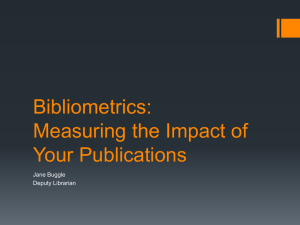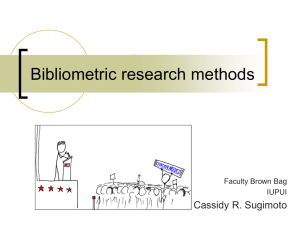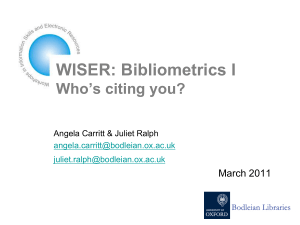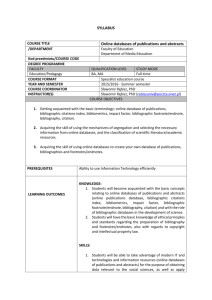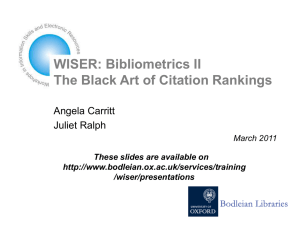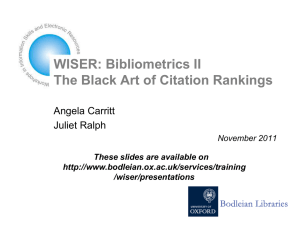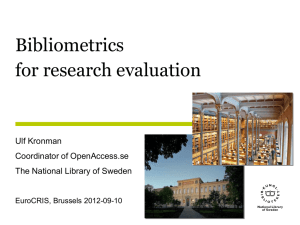Some aspect of bibliometrics
advertisement
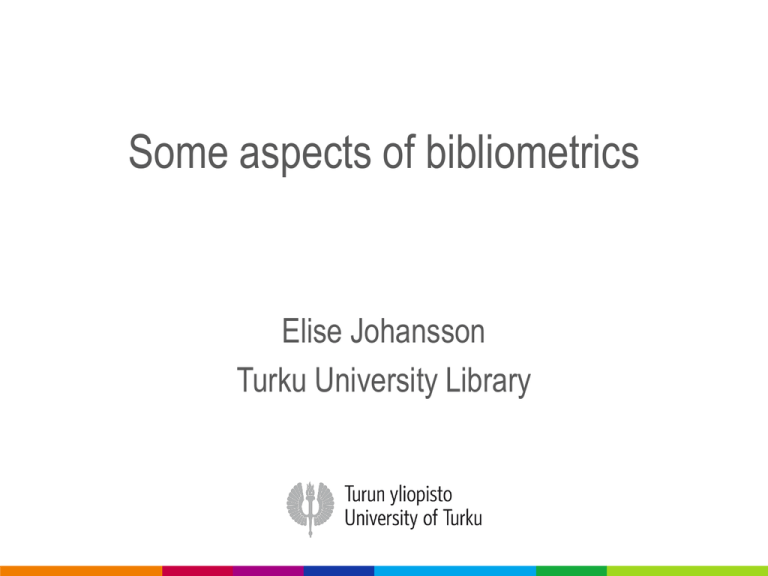
Some aspects of bibliometrics Elise Johansson Turku University Library What is bibliometrics • Bibliometrics is the application of mathematical and statistical methods to publications (from biblos: book and metron: measurement). • Bibliometrics is often used to assess scientific research through quantitative studies on research publications What can we measure with bibliometric analyses in general • Producers (authors, research institutes, countries) • Products = publications (journal articles, books, patents, webpages or blogs) • References = works mentioned in the reference list, citations in the reference list and links between different websites • Terms= words or concepts that describe the content of the publication Research on producers • Only researchers that do publish are included • To look at only one researcher is usually not reasonable • Often is looked at • • • • • Research groups Research Institutions Companies Countries or geopolitical regions Branch of science Research on publications • Can be narrowed in several ways • According to subject, in one or several countries in the time range specified • Peer reviewed scientific articles • Articles published in a journal at a certain time • Articles published in a country at a specific time range • Etc. Research on publications • With publications you can for example compare publishing between countries • Always remember to check which language regions are represented, which not. Research on references, citations and links • If an author is mentioned in the reference list, he gets a citation • Citation analysis is the best known form of bibliometric research • A high number of citations shows a broad interest and of being well-known. This is often taken as a sign of high quality • Citation analysis is used as a method in research evaluation Citation analysis • There are many reasons why a publication gets a citation. E.g more exact information, explanation of a research method, to prove one’s own opinions or to criticise other authors results • Most cited articles are describing well a research method or are review articles • Despite the reason of citing, the citation tells that the author knows the existence of the cited article Citation analysis and data sources • The information can be gathered manually (slow ) • Or searched from • Thomson Reuters Web of Science database • Elsevier Scopus Database • Google Scholar • More: Toolbox of Research Citation analysis and Citation enhanced databases Citation analysis and data sources • The sources (WoS, Scopus, Google Scholar) vary in content. There is no database that would list all publications in the world • Journals are the predominant publication type in databases • In Scopus, citation data extends back to 1996 for all disciplines Web of Science and Scopus • Web of Knowledge: Web of Science (WoS) and Journal Citation Reports (JCR) • Scopus and SCImago’s Journal and Country Rank Google Scholar • Google Scholar consists primarily of scholarly articles including journal papers, conference papers, technical reports or their drafts, theses, pre-prints, post-prints, abstracts and court opinions. • Google Scholar's strength is the broad scope of content for both types of publications and disciplines. • However, quality of data does not match the standards of Web of Science or Scopus. Google Scholar • Use Publish or Perish to retrieve, 'clean' and analyze academic citations from Google Scholar • Tool: Author impact analysis • More information About bibliometric data • Each measure and tool has advantages and disadvantages. • Citations take time to accumulate • The raw count of citations and analyses depend on database content • Bibliometrics are best applicable to the fields of medicine and natural sciences Bibliometrics and Social Sciences & Humanities • In social sciences and humanities monographs and edited books are still a very common type of publication. • Publishing for non-academic audience is important in SSH fields. • Bibliometrics are less suited to the Social Sciences and Humanities because books are usually not indexed in citation databases and citations in general take more time to accumulate. • Journal coverage in Scopus is more comprehensive than in Web of Science for the Humanities and Social Sciences. Bibliometrics in measuring research activity • Number of publications (all fields) • Number of cited publications and the total number of citations( for specific fields) • Number of times a publication has been cited (for specific fields) • H-index (for specific fields) • Journal Impact Factors (for specific fields) H-index, Hirsch Index • Based on a scholars most cited publications • A scholar with an index of h has published h papers each of which has been cited in other papers at least h times • H-index=10 means that the scholar has 10 articles that are cited at least 10 times • The h-index cannot be used off-hand to compare researchers of different areas Impact factor (IF) • Measures the amount of citations of articles published in a certain journal • Are published annually in Thomson Reuters Journal Citation Reports database • Used in research evaluation. Determines the quality of published articles . The higher the impact factor, the higher the quality of the journal • The impact factor is used to compare different journals within a certain field of research Publication Forum (Julkaisufoorumi / JUFO) • The funding for Finnish universities will be partially based on publication activity based on Publication Forum criteria. • The Publication Forum system is based on quality classification of scientific publication channels - journals, publication series and book publishers - in all research fields. The rating levels: 1 = basic; 2 = leading; 3 = top • Publication Forum classification is not suited for interdisciplinary comparisons or the evaluation of single publication or researcher. (Instructions) Thank you! Elise Johansson elise.johansson@utu.fi
